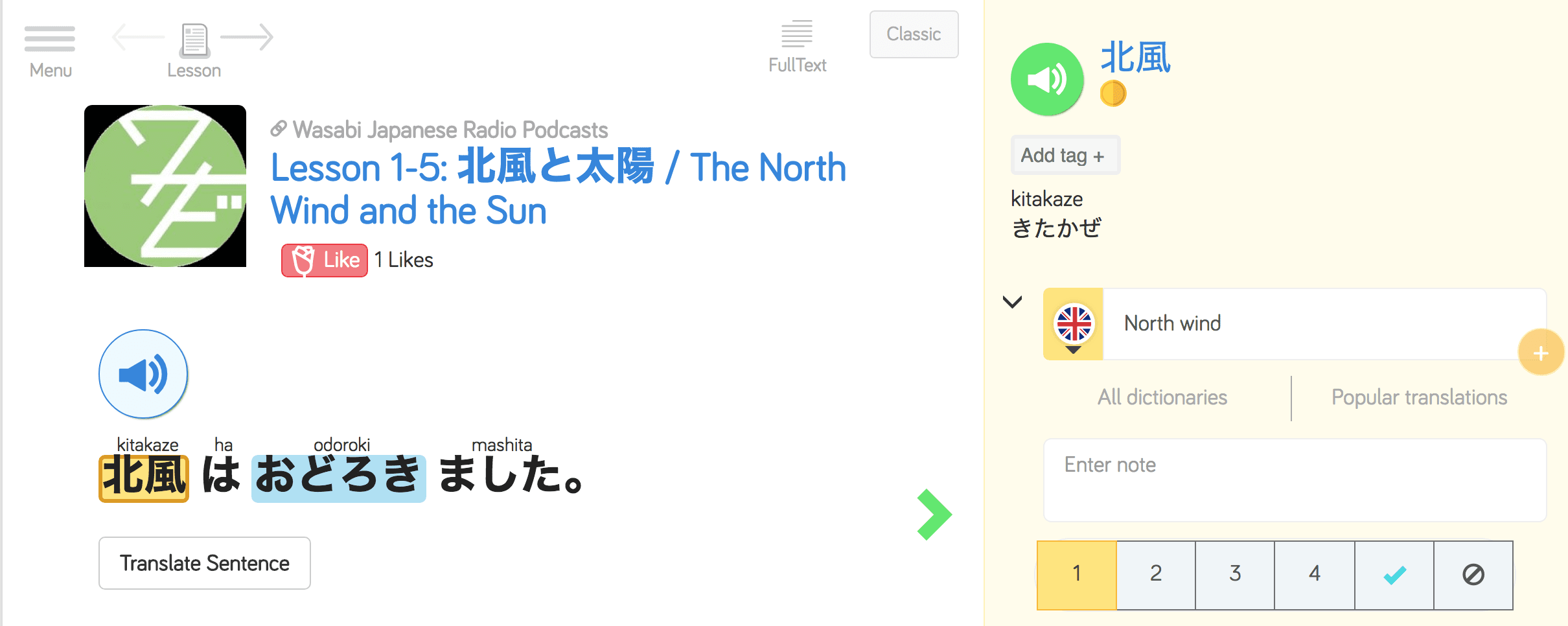Japanese Onomatopoeia: A Guide
Onomatopoeia are words that describe how something sounds. Examples include bam, pow, or meow.
In English, you might expect to hear/read onomatopoeia in children’s books about what animals or in comics, but not so much in everyday conversation. However, in Japanese, you’d be surprised how much onomatopoeia is used fairly regularly.
With this regular usage, there’s quite a bit to know about Japanese onomatopoeia. For instance, there are literally thousands of onomatopoeia words to know in Japanese!
But don’t fret, onomatopoeia words can be very instinctive. For instance, if I told you that one was describing a low-pitched clanking sound and one a high-pitched clanking sound, you could most likely guess which was which between きんきん (kinkin) and ごんごん (gongon). It just sounds right that “gongon” is descriptive of something low-pitched and “kinkin” as something high-pitched.
If I told you that さらさら (sarasara) described a silky-smooth surface, it just seems right that ざらざら (zarazara) describes a more rough surface, and so it is.

In Japanese, there are three major groups of onomatopoeia words. They are:
擬声語 (giseigo): These are the sounds that animals (including us humans) make.
擬音語 (giongo): These are sounds that inanimate objects make.
擬態語 (gitaigo): These are words that represent states of being.
If you know about the Japanese writing system, you may be wondering how to commonly write onomatopoeia sounds. Well, some onomatopoeia even have kanji!
Thankfully for those who don’t like to memorize, onomatopoeia is usually written in kana. Both katakana and hiragana are used in writing onomatopoeia, and really it is up to the author what they want to use. Throughout this article, for consistency’s sake, I use only hiragana.

The Three Types of Japanese Onomatopoeia
Below I outline three different categories of Japanese onomatopoeia.
The best way to learn these kinds of words is by seeing them in context. The LingQ Japanese library is full of interesting lessons to suit all interests. Why not sign up for a free account today and see how learning on LingQ accelerates your language skills.

擬声語 (Giseigo)
These words are like what you learned as a young child – the cow goes moo, etc. – but they also include things like human laughter and other human sounds (think of the English “haha!”).
Here are many important ones to know concerning animals:
わんわん (wanwan)
This is the sound a dog makes when barking. Think of it like “woof”.
にゃー(nya-)
This is like “meow”, the sound a cat makes.
ちゅんちゅん (chunchun)
This is the general sound of a bird. Think of it like a “chirp” or “tweet”.
けんけん (kenken)
This is the sound of a chicken, like “cluck” in English. This is also the sound a fox makes.
がーがー (ga-ga-)
This is like “quack”, the sound a duck makes.
ほーほー (ho-ho-)
This is like “hoo”, the sound an owl makes.

かーかー (ka-ka-)
This is the sound a crow makes, very similar to “caw”.
もーもー (mo-mo-)
This is the sound a cow makes, like “moo”.
がおー (gao-)
Think of this like “growl” in English. It is used for big creatures like bears.
ひひいん (hihiin)
This is the sound horses make. Think of it like “neigh”.
ぶーぶー (bu-bu-)
This is like “oink”, the sound a pig makes.
めーめー (me-me-)
This is what a sheep sounds like. Think of it like “bah” in English.
うきうき (ukiuki)
This is like “oo oo ah ah” in English, the sound a monkey makes.
げろげろ (gerogero)
This is the sound a frog makes, like “ribbit”.
ちゅーちゅー (chu-chu-)
This is the sound a mouse makes, like “squeak”.
ぶーーーん (bu—n)
This is like “buzz”, the sound a bee makes.

That should cover a lot of common animals. The following are common noises us people make:
あはは (ahaha)
This is like “haha” and refers to people laughing.
うわーん (uwa-n)
This is the sound of a baby crying, like “waah”.
きゃー (kya-)
This is what it sounds like when people scream, like “aah”.
くすくす (kusukusu)
This is for quiet laughter.
うふふ (ufufu)
This is laughing as if I know something you don’t. In English, I would try to say it is something like “hm hm hm”.
あほん (ahon)
This is like “ahem”, a sound of clearing your throat to redirect attention.
擬音語 (Giongo)
This category of Japanese onomatopoeia words depicts sounds that inanimate objects make, like the rumbling of thunder. We have less uniform versions of these sounds in English, but here are some of these words in Japanese:
ぴゅーぴゅー (pyu-pyu-)
This is the sound of strong wintry winds.
こぼこぼ (kobokobo)
This is what water bubbling gently sounds like.
ごろごろ (gorogoro)
This is the sound of thunder or of something heavy rolling, like a boulder chasing after you in a booby trapped Egyptian tomb.

ざーざー (za-za-)
This is the sound of heavy rain.
たたたた (tatatata)
This is the sound of footsteps, as if someone is running quickly.
さくさく (sakusaku)
This is the sound of stepping on sand.
擬態語 (Gitaigo)
This category covers words that represent actions, motions, or states that don’t make sounds.
These words are probably more likely to come up in conversations than the sound a cow makes, and are common in comics. Here are some ones you might be glad to know:
びしょびしょ (bishobisho)
This is descriptive of being soaked by water.
べたべた (betabeta)
This is descriptive of being sticky, especially with sweat.
さんさん (sansan)
This is descriptive of strong sunlight.
ひんやり (hin’yari)
This is descriptive of when it is cool.
きらきら (kirakira)
This is descriptive of sparkling.
うろうろ (urouro)
This is descriptive of aimless wandering.
ぶるぶる (buruburu)
This is descriptive of trembling, such as trembling with anger.
ぐっすり (gussuri)
This is descriptive of “sleeping like a baby”, as in being sound asleep.
ぐーたら (gu-tara)
This is descriptive of being lazy.
のろのろ (noronoro)
This is descriptive of being sluggish.

The next set of gitaigo is representative of emotional states:
わくわく (wakuwaku)
This is descriptive of being excited.
ざきざき (zakizaki)
This is descriptive of being heartbroken. It is also descriptive of throbbing pain, much like the pain of being heartbroken.
もやもや (moyamoya)
This is descriptive of being worried or gloomy.
もじもじ (mojimoji)
This is descriptive of being bashful or fidgety.
くよくよ (kuyokuyo)
This is descriptive of someone brooding over something.
うっとり (uttori)
This is descriptive of someone being spellbound.
Japanese onomatopoeia is one of those things that comes more naturally the more familiar you are with the language. You’ll sound much more like a native speaker if you know how to use them well.
Using LingQ is the best way to learn Japanese because it allows you to import content that you love. You can easily import any Japanese ghost story you find online (or anime, dramas, songs, and so on) into LingQ and it will automatically create a brand new lesson for you. Highlight new words and add them to your vocabulary deck. You have an infinite amount of content to learn from. Good luck!
***
Caiman Cotton is a freelance Japanese translator who has studied the language for years. He hopes to one day also study Latin.
